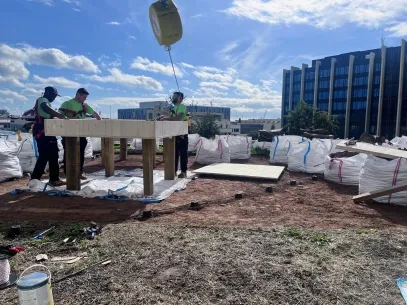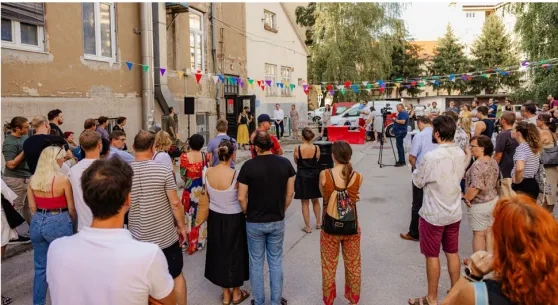1.1 Just Transitions – a pillar of EU policy and actions of European cities
Climate change poses an existential threat to humanity; a threat so great that conventional technologies and governance paradigms will not solve it. Deep systemic change and transformative action is needed (European Environment Agency 2019). The European Green Deal acknowledges this and is seeking to transform the EU into a modern, resource-efficient, and economically competitive carbon-neutral continent with net zero greenhouse gas emissions by 2050. The transformation must also be just and inclusive (European Commission 2019). In other words, it must leave no place and no person behind. The EU’s commitment to Just Transitions is not only present in the Green Deal and its priorities and in the European Climate Law, it is also reflected in its ambition to achieve the 17 UN Sustainable Development Goals (SDGs) as well as in other current EU policy priorities, such as the European Pillar of Social Rights ‒ and Just Transitions is also at the heart of the EU’s Cohesion Policy. Inclusivity is also an essential component in the approach. The EU Climate Pact, for example, as part of the European Green Deal, invites civil society and all other stakeholders to support and help deliver the Green Deal.
Just Transitions,
In this study, Just Transitions refers to the diverse and complementary approaches needed to achieve a fair, inclusive, climate neutral, and resilient economy, addressing environmental, social, and economic issues simultaneously.
Most people in Europe live in cities and towns and it is in them that the impacts of climate change and the transition towards carbon neutrality will be felt the most. The choices city residents make will have a significant impact on Europe's future and will determine how successful the Green Deal is. Cities are also the places where EU, national, regional, and local policies are implemented and where Just Transitions can be made possible. A multi-level governance approach is therefore needed to connect city residents to the national and European levels.
Consequently, cities have a central role under the new Cohesion Policy objectives, particularly under Policy Objective 5, which seeks to bring “Europe closer to citizens by fostering the sustainable and integrated development of all types of territories”. And indeed, with more than 10,000 local authorities signing the Covenant of Mayors for Climate and Energy (CoM), which commits them to reducing their greenhouse gas emissions by 55% by 2030 and adapting to the consequences of climate change, cities are also taking the lead in climate action. Moreover, they have committed to involving their citizens, businesses, and all levels of government in this effort through the design of Local Climate Pacts. The EU research Missions on Climate neutral and Smart Cities and on Adaptation to Climate Change under Horizon Europe can also support the Covenant and cities’ efforts. For climate change adaptation actions in particular, an EU Policy Support Facility developed by the CoM aims to ensure that resilience is achieved in a just and fair way.
Cities are highly vulnerable to a range of climatic phenomena and conventional responses to tackling these will not be sufficient. Testing radical policy solutions, scaling them up, and refining them, is not only possible but can make a crucial contribution to a successful socio-ecological transition. Tests or trials can provide an arena in which innovation, co-creation, and participatory citizen-led actions using technology and space can flourish (European Commission-Joint Research n.d.). As the New Leipzig Charter underlines, cities can act as “laboratories for new forms of problem-solving and test beds for social innovation” (EU 2020). As living laboratories, cities can lead the way on how to engage citizens and inspire others.
1.2 UIA projects and their link to Just Transitions
An aspiration for Just Transitions already imbues the design and implementation of urban projects in the European Union. Consequently, while not explicitly implemented under the topic of Just Transitions, many of the 86 UIA projects that have run since 2016 offer tangible approaches exploring how urban authorities can catalyse Just Transitions so that no one is left behind.
While these transformations concern all parts of society and sectors of the economy (industry, agriculture, IT, etc.), this report analyses UIA urban innovation projects in their city contexts, with a focus on their approaches to governance, tools, promising practices through the prism of three specific sub-topics relevant to the work of urban practitioners and the managing authorities of the mainstream programmes seeking to implement Just Transitions. These sub-topics are:
|
UIA Just Transition sub-topics |
||
|
Skills for a green future |
Make the Green City affordable for all |
Governance for Democratic Transitions |
The present report will focus on Governance for Democratic Transitions because this will showcase a range of experimental Just Transitions governance models for a carbon-neutral and climate-resilient Europe, and because new forms of collaboration and participatory governance are called for. Of course, the three sub-topics are closely interrelated. Transitions that are affordable to all will enable – and bring in - people of all incomes, ages, gender, educational profiles or familiarity with policy processes to participate actively in democratic transitions through co-creation and actively participating in decision-making. This will help ensure that the Transitions are just and inclusive, allowing everyone to benefit from new jobs and green renewal.
About this resource
The Urban Innovative Actions (UIA) is a European Union initiative that provided funding to urban areas across Europe to test new and unproven solutions to urban challenges. The initiative had a total ERDF budget of €372 million for 2014-2020.
Similar content




